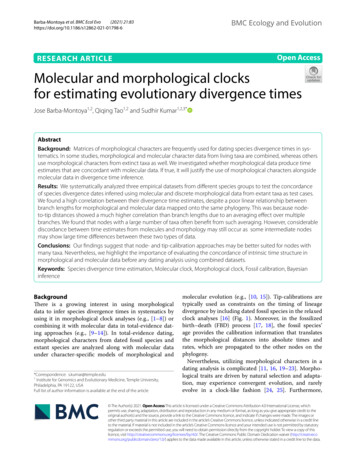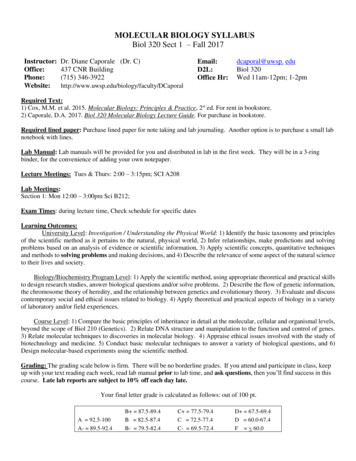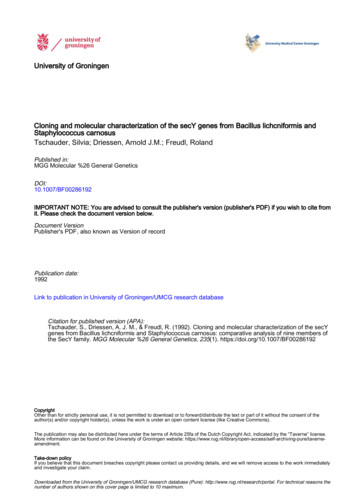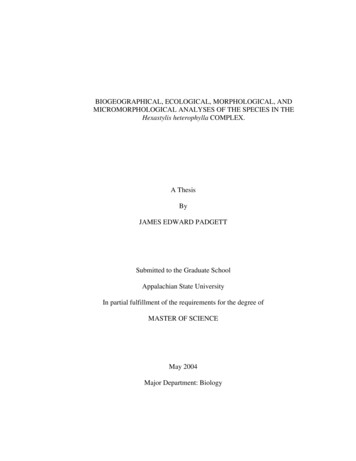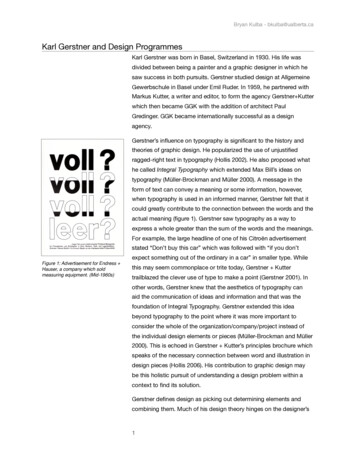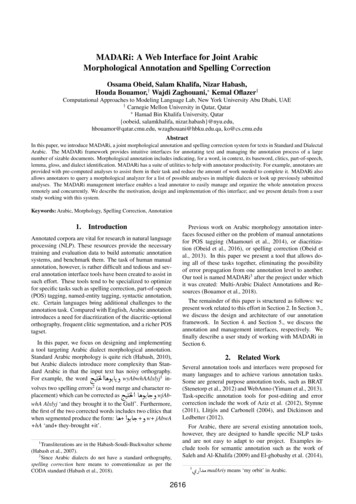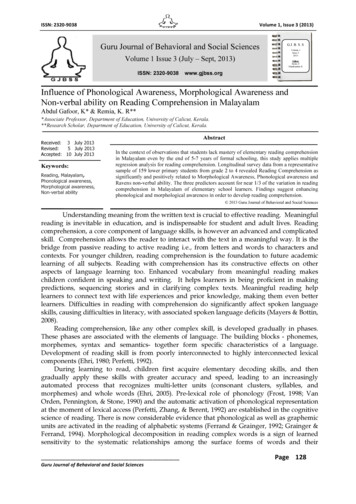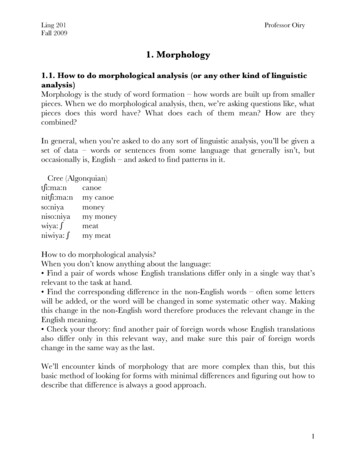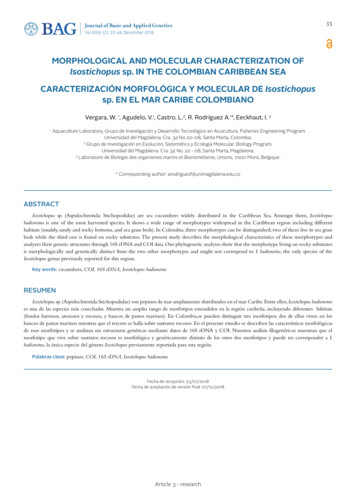
Transcription
Journal of Basic and Applied Genetics33Vol XXIX (2): 33-48; December 2018MORPHOLOGICAL AND MOLECULAR CHARACTERIZATION OFIsostichopus sp. IN THE COLOMBIAN CARIBBEAN SEACARACTERIZACIÓN MORFOLÓGICA Y MOLECULAR DE Isostichopussp. EN EL MAR CARIBE COLOMBIANOVergara, W. 1, Agudelo, V.1, Castro, L.2, R. Rodríguez A.1*, Eeckhaut, I. 31Aquaculture Laboratory, Grupo de Investigación y Desarrollo Tecnológico en Acuicultura, Fisheries Engineering Program.Universidad del Magdalena. Cra. 32 No 22–08, Santa Marta, Colombia.2Grupo de Investigación en Evolución, Sistemática y Ecología Molecular. Biology Program.Universidad del Magdalena. Cra. 32 No. 22 - 08, Santa Marta, Magdalena.3Laboratoire de Biologie des organismes marins et Biomimétisme, Umons, 7000 Mons, Belgique.* Corresponding author: s sp. (Aspidochirotida: Stichopodidae) are sea cucumbers widely distributed in the Caribbean Sea. Amongst them, Isostichopusbadionotus is one of the most harvested species. It shows a wide range of morphotypes widespread in the Caribbean region including differenthabitats (muddy, sandy and rocky bottoms, and sea grass beds). In Colombia, three morphotypes can be distinguished; two of them live in sea grassbeds while the third one is found on rocky substrates. The present study describes the morphological characteristics of these morphotypes andanalyzes their genetic structures through 16S rDNA and COI data. Our phylogenetic analyses show that the morphotype living on rocky substratesis morphologically and genetically distinct from the two other morphotypes and might not correspond to I. badionotus, the only species of theIsostichopus genus previously reported for this region.Key words: cucumbers, COI, 16S rDNA, Isostichopus badionotusRESUMENIsostichopus sp. (Aspidochirotida:Stichopodidae) son pepinos de mar ampliamente distribuidos en el mar Caribe. Entre ellos, Isostichopus badionotuses una de las especies más cosechadas. Muestra un amplio rango de morfotipos extendidos en la región caribeña, incluyendo diferentes hábitats(fondos barrosos, arenosos y rocosos, y bancos de pastos marinos). En Colombia,se pueden distinguir tres morfotipos; dos de ellos viven en losbancos de pastos marinos mientras que el tercero se halla sobre sustratos rocosos. En el presente estudio se describen las características morfológicasde esos morfotipos y se analizan sus estructuras genéticas mediante datos de 16S rDNA y COI. Nuestros análisis filogenéticos muestran que elmorfotipo que vive sobre sustratos rocosos es morfológica y genéticamente distinto de los otros dos morfotipos y puede no corresponder a I.badionotus, la única especie del género Isostichopus previamente reportada para esta región.Palabras clave: pepinos, COI, 16S rDNA, Isostichopus badionotusFecha de recepción: 23/07/2018Fecha de aceptación de versión final: 07/12/2018Article 3 - research
34INTRODUCTIONSea cucumbers are over-exploited in the three mainoceans, and started to be recently targeted in the Caribeansea (Purcell et al., 2012). Isostichopus badionotus is one of thesea cucumber species widespread in the Caribbean region(Guzman et al., 2003), ranging from North Carolina tonorthern Brazil. In addition, this species has been previouslyreported in the east to the middle-Atlantic and in the Gulfof Guinea (western Africa) (Hendler et al., 1995). It isfound at depths from 0-55m (Miller and Pawson, 1990). I.badionotus is a common shallow water species that inhabitsrocky bottoms, as well as sea grass beds (Hendler et al.,1995). In Colombia, there is an illegal, unregulated andunquantified fishery (Toral-Granda, 2008), and it is ofpotential commercial interest in Florida, Puerto Rico andthe U.S.Virgin Islands (Bruckner, 2006).At present, Colombian Caribbean Sea cucumbershave not been well studied (Rodríguez et al., 2013;Agudelo and Rodríguez, 2015) and there are many gapsin their knowledge especially related to their taxonomiccharacterization (Honey-Escandon et al., 2012; Smirnov,2012). The advances in this regard allowed the reportingof around 44 species, most of which have been capturedby exploratory fishing, and identified mainly as deep-seaspecies (Caycedo, 1978; Borrero et al., 2003; Borrero-Pérezet al., 2012; Toral-Granda, 2008; Toral-Granda et al., 2008).Since sea cucumbers are an important source of animalproteins, studies in Colombia are beginning to developthe conditions for their production under controlledenvironments (Rodríguez et al., 2013; Agudelo andRodríguez, 2015; Vergara and Rodríguez, 2015; 2016).In this way, part of the present team studied the gonadmorphology and the larval development of a species,Isostichopus sp. aff badionotus, including its spawning period(Agudelo-Martínez and Rodríguez-Forero, 2017).According to Guzmán and Guevara (2002) and ToralGranda (2008), there are three species of Isostichopusincluding I. badionotus, I. fuscus, and I. macroparenthesesdistributed in Central and South America. However, theobservation of various morphotypes inside the speciesgroups suggests the occurrence of more than three speciesfor this region. In Colombia, three morphotypes can bedistinguished in I. badionotus. The morphotypes studiedare similar because they all have a robust body, a mouthlocated ventrally, twenty pelleted tentacles, anus in terminalposition, gonads in the form of tufts, podias or ambulatoryfeet distributed in three rows, one or two poly vesicles,all these, distinctive characteristics of the Stichopodidaefamily. Preliminary phylogenetic analyses showed twomorphotypes that cluster together and one that is wellseparated from the others. Two of them live in sea grassbeds while the third is found on rocky substrates. Also,histological studies revealed a different structure of thebody wall. The present study describes the morphologicalcharacteristics of these morphotypes and analyzes theirgenetic structures through 16S rDNA and COI data.This research can be very useful to increase theknowledge about the taxonomy status of some Colombiansea cucumbers and to find out the morpho-anatomical andgenetic differences between species of genus Isostichopus,from the native populations of the Santa Marta, CaribbeanSea. This information will also be useful for conservationand management purposes.MATERIAL AND METHODSCollection of animalsDuring one year, two hundred sea cucumbers werepurchased from local artisanal fishermen in RodaderoBay (11 13′ 22.73″ N - 74 13′ 32.59″ W), Airport Bay(11 07′ 10″ N - 74 13′ 50″ W), and Taganga Bay (11 16′ 03.4″ N - 74 11’ 32.3″ W), located in Santa Marta,Magdalena, Colombia (Figure 1) and transferred to theAquaculture Laboratory (Universidad del Magdalena,Colombia). Most of the material was collected in shallowwaters (1 to 20 m depth). One hundred and thirty seacucumbers were collected between Rodadero andAirport bays while seventy were obtained from the bayof Taganga. Individuals from the three morphotypes wereweighed with an analytical scale Ohaus (0.001 g), andtheir length was measured with a standard measuringboard (mm). Photographs of the dorsal and ventral sidesof the body were taken by using digital camera (CannonEOS, Rebel XTi). Besides the external and internalanatomical observations, skin samples, tentacles and podiawere taken for reviewing ossicles. Samples were dissolvedin 10 % sodium hypochlorite for 10 min and rinsed withwater as described by Lambert (1985), and examinedmicroscopically through slide preparations. For this, theanimals were anesthetized by immersion in sea water withice and then sacrificed. The characterization was madeby comparison with Tommasi (1969) and Purcell et al.,Article 3 - research
Journal of Basic and Applied GeneticsVol XXIX (2): 33-48; December 201835Figure 1. Marine and coastal areas of Colombia Caribbean Sea (modified by José Viillacob). Blue points in thestudied areas.(2012). Our results showed that the specimens of the threemorphotypes came from two lineages of Isostichopus species(Isostichopus badionotus and Isostichopus sp., characterizedin this report) that were recorded in the Center ofBiological Collections of Universidad de Magdalena (SantaMarta, Magdalena, Colombia) (CBUMAG:ECH:00001,CBUMAG:ECH:00002, CBUMAG:ECH:00003).DNA extraction, amplification and sequencingTwenty-seven individuals were dissected and preserved inabsolute ethanol (99.5 % ). DNA extraction was performedfrom up to 15 mg of muscle tissue using the DNeasy Blood &Tissue Kit (QIAGEN).The quality of the DNA was verifiedon a 1 % agarose gel stained with GelRed (Biotium). PCRamplification of the COI gene was performed using theprimers co1eF (5’-ATAATGATAGGAGGRTTTGG-3’)and co1eR (5’-GCTCGTGTRTCTACRTCCAT-3’)(Arndt et al., 1996), and of the 16S gene with theprimers 16Sas (5’-CGCCTGTTTATCAAAAACAT-3’)and 16Sbr (5’-CTCCGGTTTGAACTCAGATCA-3’).PCR reactions were performed with 2 μL templatein a 25 μL volume with final concentrations of 2 mMMgCl2, 5X PCR buffer (no MgCl2 BIOLINE ), 0.4 μMof each primer, 0.4 μM of each dNTP, and 2 units Taq(BIOLASETM, BIOLINE ). PCR amplifications wereperformed under the following conditions: 1 min at 95 C, followed by 35 cycles of 15 s at 95 C, 1 min at 40 C,1.5 min at 72 C, and there was a final extension periodof 5 min at 72 C. The PCR products were verified on a2 % agarose gel stained with GelRed (Biotium). FollowingArticle 3 - research
36amplification, PCR products were purified using theMACHEREY-NAGEL kit (NucleoSpin Extract II), andboth strands were sequenced in both directions.Sequence analyses and molecular phylogenetic analysesPrimer sequences were removed from the start and the endof the obtained sequence and sequence ambiguities wereresolved by comparing the electropherograms using theprogram BioEdit v. 7.0.5.3 (Hall, 1999). After trimming,forward and reverse sequences for each specimen wereassembled. Each assembled sequence was examined andedited by hand, and each sequence was checked for stopcodons (in the case of the COI data file). Finally theconsensus sequence from each contig was verified usingthe Blast tool on NCBI (www.ncbi.nlm.nih.gov). Theobtained sequences and downloaded sequences fromGenBank were aligned using the ClustalW algorithm(Thompson et al., 1997) in MEGA 6 (Tamura et al., 2013).The downloaded sequences were, for the COI data set,one sequence of I. badionotus (EU848276.1), one COIsequence of Isostichopus sp. (FJ971400.1), five sequences of I.fuscus (AF486424.1/28.1), three sequences of S. herrmanni,and one sequence of Holothuria leucospilota (KC405565.1);for the 16S data set, one sequence of I. macroparentesis(AY338415.1), two sequences of I. badionotus (JN207495.1,EU822435.1), six sequences of I. fuscus (AY153494.1,AY153499.1), three sequences of Stichopus herrmanni(EU822451.1, EU856636.1, FJ223863.1), and onesequence of Holothuria leucospilota (JQ657266.1). The COIfinal alignment was of 665 bp, and the 16S final alignmentwas of 508 bp. Sequences were submitted to GenBankunder accession numbers KX383967-KX384018.Sequence divergences were calculated using the K2Pdistance model (Kimura, 1980) following the barcodingapproach suggested by Hebert et al. (2003; 2004).Phylogenetic analyses were made performing a NeighbourJoining (NJ) tree with a distance matrix generated by usingMEGA 6 (Tamura et al., 2013). Bootstrap values wereobtained by making 1,000 replicates. Bayesian analyseswere also performed using MrBayes (Ronquist andHuelsenbeck, 2003), by considering the best substitutionmodels for each region using MrModelTest 3.7 (Nylander,2004). Two independent runs of 2,000,000 generationswere performed, with trees sampled every 100 generations,25 % of the trees were discarded as burning. Convergencewas validated by the standard deviation of split frequencies( 0.01), by plotting the likelihood values over time, andby using the sump command in MrBayes. The percentageof trees recovering a particular clade was used as a measureof that clade’s posterior probability (Huelsenbeck andRonquist, 2001).RESULTSMorphological analysesMorphotype IDescriptionSeventy adults with average weight 232.4 44.7 g,one specimen of 1 kg. Body is elongated, cylindrical,completed in rounded ends. The species presents varietiesin body colorations (brown, reddish, yellow), size and inthe ending of the body edges (Figure 2).Specimens have brown coloration and numerousconical warts colouring brown. The dorsal side of thebody presents a variable number of rectangular shapeprotuberances caused by depressions at the corners. Thismorphotype has an organization similar to four rows oflow projections with small central spots that give it anappearance of breasts. In the two dorso-lateral marginsthere is only one row of warts and two more in the ventrolateral body. The ambulacral feet are of brown color withthree lines of longitudinal podiums.Calcareous ring composed of projections in the formof pyramid and tower by way of a wheel, with a markedinvagination at the base, with two small mountains orbumps on its outer edge. A respiratory tree and one ortwo poly vesicles are present. No presence of tubules ofCuvier. Gonads are placed in clusters, coloring whitecreamy, depending on the maturity gonad stage. Maturefrom July to November. Digestive tract is two times longerthan body length, cylindrical beige, which occupies threetimes the length of their body.Ossicles:Towers, canes, in the shape of s and c, in badgesperforated (Figure 3).Habitat (or ecology)These specimens have been found in Colombia CaribbeanSea in Rodadero beach (11 12′ 25.5″ N - 74 13′ 54.8″W), Airport beach (11 09′ 20.2″ N - 74 13′ 56.6″ W), andmainly in Taganga bay (11 15′ 53.0″ N - 74 11′ 32.0″ W).They inhabit sandy bottoms and have cryptic behavior.Theyfeed on particulate material that includes algae, bacteria andmarine sediment. Mature from July to November.Article 3 - research
Journal of Basic and Applied GeneticsVol XXIX (2): 33-48; December 201837Figure 2. Isostichopus badionotus. a) Morphotype I. Typical morphotype, solid beige in the dorsal side, which iscovered with dark chocolate round warts. b) Morphotype II. 1) Orange sea cucumber. The dorsal side iscovered by orange warts that end in a dark color. 2) Dark sea cucumber surrounded by yellow round warts. 3)Ambulacral feet organized in three rows with podias that end in a dark color.Article 3 - research
38Figure 3. Isostichopus badionotus ossicles. a) Perforated tables, b) larger plates, c), d) and e) C-shaped rods, f)S-shaped rods.Morphotype IIDescriptionAdults with average weight 470.4 162.8 g, onespecimen of 1 kg. Body is elongated, cylindrical, completedin rounded ends. These specimens present varieties incolorations (brown, reddish, yellow), size and in the endingof the edges (Figure 2).The body is light brown and on its surface has tiny palespots with small, almost imperceptible dark papillae. Theyshowed elongated body, cylindrical or fusiform, robust,with blunt edges. The ventral region is flat and the dorsalregion is concave. The ventro-lateral margin is devoid offleshy projections. The podiums are dark coffee arrangedin three longitudinal rows, the middle one being thickerthan those of the lateral ones. They have dark browncoloration with tiny conical pinnules, which colouringreddish-brown, whose endings are yellow in colour (Table1). The mouth position is ventral and the anus, terminal.Eighteen to twenty peltates tentacles and anal openingwithout tooths. Presence of tube feet arranged in threerows, which become six rows when observed in the water.Their terminal colour is brown (Figure 2).Article 3 - research
Journal of Basic and Applied GeneticsVol XXIX (2): 33-48; December 201839Table 1. Comparative characters among sea cucumber speciesSpeciesNew proposed species (MIII)Isostichopus badionotus MITotal length (mm)20Average weight (g)192.9 61.6243.3 70470.4 162.8Body shapeThin and rigidRobust and flexibleRobustBody colorBrown with coffee, orange orFrom yellow to diverse brownMost of them have brownreddish dermal dedDermal papillae shapeSharp-pointedRounded with of chocolate chipVery small rounded endings withterminationsyellow terminations25Isostichopus badionotus MII30Podia3 beige rows3 beige rows3 rows, with brown lTerminalTerminalRespiratory treePresencePresencePresenceGonadsArranged in clusters, beige, greenand yellow-greenish colorationArranged in clusters, whitecreamy colorationArranged in clusters, whitecreamy colorationMature broodstockJuly to NovemberJuly to NovemberJuly to NovemberDigestive tractLong, cylindrical digestive tube,Long, cylindrical digestive tract,Long, cylindrical digestive tract,beige, with reddish pharynx.beige. Occupies three times thebeige. Occupies three times theTwice the length of its bodylength of its bodylength of its bodyDigestive tractweight (g)7.9 3.08.2 4.012.1 5.0HabitatSandy bottomsRocky bottomsRocky bottomsCalcareous ring composed of projections in the formof pyramid and tower by way of a wheel, with a markedinvagination at the base, with two small mountains orbumps on its outer edge. A respiratory tree and one ortwo poly vesicles without tubules of Cuvier are present.Gonads are placed in clusters, coloring white-creamy,depending on the maturity gonad stage. Mature from Julyto November. Digestive tract long, three times longer thanbody length cylindrical beige, which occupies three timesthe length of their body.Ossicles:Towers, canes, in the shape of s and c, in badgesperforated (Figure 3).Habitat (or ecology)These specimens have been found in the ColombiaCaribbean Sea, mainly in Taganga bay (11 15′ 53.0″ N- 74 11′ 32.0″ W), inhabiting sandy bottoms. They feedon particulate material that includes algae, bacteria andmarine sediment. Mature from July to November.Morphotype IIIDescriptionAdults with average weight around 192.9 61.6 g.Body is elongated, cylindrical, completed in blunt ends.The species presents varieties in colorations in the dorsalArticle 3 - research
40Figure 4. New proposed species. a) Variations in irregular spots. Trapezoidal-shaped body. 1cm bar scale. b). Variations inbody color. c) Close view of the peltates tentacles of Isostichopus isabellae n sp. d) Peltates tentacles contractedof the new proposed species. Lateral view. e) Ambulacral feet organized in three rows (arrows) with most of thepodia ending in a cream color rather than in black (white line). Mouth ( ), pinules (*).region, which are cream-yellow with irregular spots: coffee,orange or reddish. Its ventral region and the tube feet arebeige (Figure 4) (Table 1).Mouth is ventral with 16-20, peltate tentacles, anus isterminal without teeth (Figure 4). Presence of ambulacralfeet arranged in three rows. The dorsal region was slightlycurved while the ventro-lateral margin of the wall wasthick and provided with extensions called papillae.The calcareous ring has a pyramid form and tower withtwo small bumps on its top edge. Presence of respiratorytree. Presence of poly (1-2) vesicles without tubules ofCuvier. Gonads arranged in clusters, beige, green andyellow-greenish coloration, depending on the maturitygonad stage. Female gonads tubules reaching a diameterof 405.07 248.19 µm. Male gonads with thinner tubuleswhich diameter was around of 272.18 56.37 µm. Matureoocyte diameter: 125.24 13.11 µm. Cuvierian organabsent. Long, cylindrical digestive tube of beige colour, withreddish pharynx, twice the length of its body (Figure 5).Ossicles: tables terminated in a crown, perforated byfour central holes, c and s shaped rods, rounded and largerplates whit several holes (Figure 6).Habitat (or ecology)It inhabits rocky and sandy and feeds on particulatematerial that includes algae, bacteria and marine sediment.The species have been found in Rodadero beach, Airportbeach, Taganga bay. Gonochoric species with bifurcatedgonad attached to dorsal mesentery. Mature from July toNovember.RemarksMost of them are smaller in size than Morphotype Iand II. They have a trapezoidal-shaped body, which is thinand rigid. They show dorsal irregular spots and differentcolours that varies from coffee, to red, orange and beige,Article 3 - research
Journal of Basic and Applied GeneticsVol XXIX (2): 33-48; December 201841depending on the individual. Conical pinnules. Ossiclesare similar to that other Isostichopus. Seasonal spawningfrom July to November.Sequence and phylogenetic analysesTables 2 and 3 show the divergent nucleotidesequences of the COI and 16S nucleotide alignments.For the COI gene three haplotypes corresponding to thethree morphotypes where found (Table 2). The 16S geneis more variable, as expected, and we found more than onehaplotype for morphotype III (Table 3). The results of ourphylogenetic analyses are presented in Figure 7 and Figure8. Both the NJ and the Bayesian analyses, for both genes(COI and 16S), recovered the same tree topology.The phylogram obtained by Neighbor-joining andBayesian analysis derived from COI sequences (Figure7) showed that the three morphotypes of the so-calledIsostichopus badionotus species form two well separatedclades: one with all morphotype III (M3) individuals andthe other including all morphotypes I (MI) and II (MII).The “morphotype III” clade also includes a sequenceretrieved from GenBank identified as Isostichopus sp.,the sister group of the “morphotype III” clade I. fuscus.The “morphotype I II” clade also includes a sequenceretrieved from GenBank identified as Isostichopus badionotus.This clade forms the sister group of the clade formed bymorphotypes III and I. fuscus.The COI distance matrix indicated that the averagedistance percentage for Isostichopus was 0.20%, whilethe average between species distance value was 7.80%.Comparisons with S. herrmanni sequences indicated that thebetween genera distance average value was 16% (Table 2).For the 16S distance matrix we obtained similar results,however, the sequence of I. macroparentheses available inGenbank is genetically very different from other Isostichopussequences. In this case the average within species distancepercentage for Isostichopus was of 0.5 % , while the averagebetween species distance value was of 13.78 % . Thedistance values between I. macroparentheses and the otherIsostichopus species were higher than the distance valuesobtained between the other Isostichopus species andStichopus herrmanni (Table 3). One 16S sequence of I.badionotus (JN207495.1) clusters within the “MorphotypeIII” clade.Figure 5. Internal morphology of the new specie proposed. 1) Pigmented polian vesicle; 2) Respiratorytree; 3) Gonads; 4) Intestine; 5) Internal muscle; 6) Skin.Article 3 - research
42Figure 6. Ossicles of the dorsal body wall of the new specie proposed. a) Perforated tables with a single central hole, foursmaller peripheral holes that end in crown as towers b) Rod with small holes, c) Rod of tentacles d) C-shaped rod,e) Perforate round plates of the dorsal body wall, f) Panoramic view of ossicles samples: very small tables, largerplates, rods some with holes.Table 2. Comparison of Santa Marta Isostichopus COI sequences from the three found morphotypes and other sequencesavailable in Genbank. Numbers indicate divergent nucleotide positions along the alignment. Dots correspond toconserve nucleotides. Only sequences representative of each different haplotype are shown.Article 3 - research
Journal of Basic and Applied GeneticsVol XXIX (2): 33-48; December 201843Table 3. Comparison of Santa Marta Isostichopus 16S sequences from the three found morphotypes and other sequencesavailable in Genbank. Numbers indicate divergent nucleotide positions along the alignment. Dots correspond toconserve nucleotides. Only sequences representative of each different haplotype are shown.Article 3 - research
44Table 3. (continues)Figure 7. Tree topology obtained by Neighbor-joining and Bayesian analyses derived from COI (cytochrome c oxidase I)sequences showing two genetically distinct lineages of Isostichopus in Colombia. Sequences downloaded fromGenBank are coded with each accession number. Asterisks represent posterior probabilities/booststraps thatwere 0.90/90%, diamonds represent posterior probabilities/booststraps that were 0.80/80%.Article 3 - research
Journal of Basic and Applied GeneticsVol XXIX (2): 33-48; December 201845Figure 8. Tree topology obtained by Neighbor-joining and Bayesian analyses derived from 16S rRNA sequences showingtwo genetically distinct lineages of Isostichopus in Colombia. Sequences downloaded from GenBank are codedwith each accession number. Asterisks represent posterior probabilities/booststraps that were 0.90/90%,diamonds represent posterior probabilities/booststraps that were 0.80/80%.DISCUSSIONFor years, there have been great controversy around thecategorization of species worldwide and Colombian seacucumber is no exception. Genetic studies are definitivefor the understanding of the taxonomic identification ofsea cucumbers. A species under a certain area can be easilyconfused or mistakenly classified if only its macroscopiccharacters are observed. There are pronounced differencesbetween the two lineages studied in this work. One ofthe main features is that I. badionotus has strong chocolatespots with well pronounced edge, while Isostichopussp. (morphotype III) presents different brownish spotsdistributed on the dorsal surface of the body. Thismorphotype was characterized by having a trapezoidalshaped body, which is in contrast to I. badionotus whohas the ventral region flat and the dorsal region concave.Isostichopus sp. (morphotype III) was found always in rockybottoms while I. badionotus was found in sandy bottomsas was state by Purcell et al., (2012). Additionally, themorphotype III digestive tract length, which occupiestwice the length of its body in contrast to three times thelength for I. badionotus. Our findings suggest morphotypeIII, could be a different species of Isostichopus.Genetic evidence for taxonomic divergenceSince its appearance the DNA barcoding approach hasbeen proposed as a strategy that could help on speciescharacterization and discovery by allowing taxonomiststo rapidly sort specimens and by highlighting divergenttaxa that may represent new species (Hebert and Gregory,2005). The increase in DNA-barcoding initiatives hasArticle 3 - research
46led to the realization that, for a significant proportionof species, there is an actual correlation between geneticdivergence and taxonomic status (Hebert et al., 2004). Forthe application of genetic barcodes we need to analyzethe genetic divergence between and within species (interand intra-genetic distances), so that, for a given geneticmarker (typically the COI gene), the lowest interspecificvalue does not overlap with the highest intraspecific value,maintaining a gap also called the “barcoding-gap” (Hebertet al., 2003). This threshold, depending on the organismsand the study, seems to lie around 2-4 % (Hebert et al.,2003; Meyer and Paulay, 2005). Although the COI hasproven to be a useful tool for the characterization ofspecies in the Holothuroidea (Uthicke et al., 2010), the16S rRNA gene has also been successfully tested for thispurpose (Kamarudin, 2015; Wen and Zeng, 2014). In thisstudy we evaluated the potential use of the COI and 16SrRNA genes for the characterization of Isostichopus speciesin Colombia.In Uthicke s et al. (2010) barcoding study with COI,conspecific sequence variation averages of 1.3 % (numbersbetween 2.0 and 4.5 % ) and a congeneric average value of16.9 % were obtained, showing a clear “barcoding gap”. Inour study, the average COI within-species distance valuewas of 0.20 % , while the average between-species distancevalue was of 7.80 % . We also obtained a clear “barcodinggap”. Comparisons with S. herrmanni sequences indicatedthat the average between-genera distance value was of16 % . Both for the COI and the 16S genes we foundlarger genetic distances values between Isostichopus sp.morphotype III and I. badionotus (morphotypes I and II)than between either of those with I. fuscus. Unfortunaltythere is very little genetic information published inGenbank for the group. Although we tried to include theonly 16S sequence available for I. macroparentheses, thissequence clearly does not belong to this species. Whenthe sequence is compared to others in the dataset usingthe Blast tool, it matches another Istichopodid, Astichopusmultifidus. Our tree reconstructions (both genes) showedthe presence of two Isostichopus well differentiatedgroups. These barcoding results, corroborated by themorphological analyses, suggest that there might be twoIsostichopus lineages or species in our Colombian samples.Furthermore, although we initially thought that themorphotype II could also be different to I. badionotus dueto its external morphology, as proposed in Vergara andRodríguez (2015), the genetic results revealed that it ispart of the variety of morphotypes of the I. badionotusspecies. Nevertheless, its external characteristics, as well asthe ossicles conformation directed the studies to analysis ofgenetic sequences that allowed us to confirm the presenceof two lineages of Isostichopus in the Colombian Caribbean.Isostichopus includes ten nominal Atlantic species: I.assimilis, I. maculatus, I. acanthomela, I. badionotus, I. diaboli,I. errans, I. haytiensis, I. macroparentheses, I. moebii and I.xanthomela (Heilprin, 1888).While in the present literatureonly two Atlantic species are recognized, it is quite possiblethat the morphotype III encountered here represents adescribed species currently relegated into the synonymy ofI. badionotus. In order to confirm the taxonomical status ofthe Colombian Isostichopus, all these nominal species needto be evaluated on the basis of their descriptions and types.It is well known that studies that confirm the taxonomicclassification of the species are an essential too
Bootstrap values were obtained by making 1,000 replicates. Bayesian analyses were also performed using MrBayes (Ronquist and Huelsenbeck, 2003), by considering the best substitution models for each region using MrModelTest 3.7 (Nylander, 2004). Two independent runs of 2,000,000 generations
